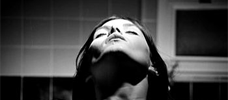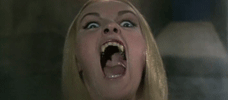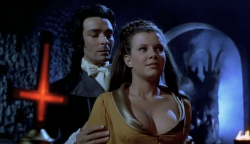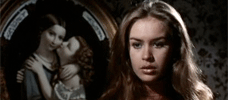Reviews
Roy Ward Baker
UK, 1970
Credits
Review by Leo Goldsmith
Posted on 15 February 2011
Source MGM DVD
Categories Lesbian Vampires
The series of loosely associated films known as the Karnstein Trilogy represents Hammer Films’ strident foray into the domain of the lesbian vampire, a subgenre-defining moment that launched the company from an increasingly musty set of genre franchises into one of the defining producers of exploitation cinema of the 1970s. Based with incrementally increasing artistic license on Sheridan Le Fanu’s highly influential 1872 novella, Carmilla, the films of the trilogy - The Vampire Lovers, Lust for a Vampire, and Twins of Evil - represent the libidinous core of the lesbian vampire subgenre, scripted by Danger: Diabolik and Barbarella contributor (and, later, important trade-unionist) Tudor Gates and boasting a seemingly interminable lineage of blood-thirsty, polyamorous nymphs. Over the next three days, join us as we studiously trace the genealogy of the Karnstein family.
Think me not cruel because I obey the irresistible law of my strength and weakness; if your dear heart is wounded, my wild heart bleeds with yours. In the rapture of my enormous humiliation I live in your warm life, and you shall die - die, sweetly die - into mine. I cannot help it.
—Sheridan Le Fanu, Carmilla (1872)
1970 was a propitious time to be a lesbian vampire. Just short of a century after the publication of Sheridan Le Fanu’s hugely influential 1872 novella Carmilla, Britain’s Hammer Films was busily churning out sequels to their Dracula, Frankenstein, and Cave Girl franchises and groping for fresh material. At the same time, the western cinema world’s censorship laws were “maturing”: the social habits of the Swedes were aggressively piquing curiosity all over the world, Doris Wishman and Russ Meyer were unveiling their fantasies in the grindhouse without recourse to the guise of “naturism,” and mainstream cinema was busy playing catch-up with Hugh Hefner. In this regard, Hammer was somewhat slow to react to this increase of flesh—or at least to find ways of getting away with it. But soon the trademark taut bodices got a bit more lax, and the plunging necklines plunged still further.
The Vampire Lovers was not quite the first Hammer film to feature naked bodies - Taste the Blood of Dracula beat it to the punch by a few months - but its scandalous sexual subject matter makes it far more interesting than many a musty Hammer franchise product. It also made the project more risky, but then director and Hammer stalwart Roy Ward Baker and screenwriter Tudor Gates (his real name!) had a reasonably respectable literary source to fall back on. Le Fanu’s gothic classic had already been adapted many times, inspiring both the scientistic nature of Stoker’s Dracula and the evanescent wooziness of Dreyer’s Vampyr. While these lofty points of references were likely not in the forefront of Hammer’s hive-mind during production of their saucy, historically sketchy chompfest, they nonetheless helped to justify some of its more brazen girl-on-girl excesses. After all, the sight of the mysterious Carmilla Karnstein sinking her teeth into young Emma Morton’s naked breast is not salacious pervmongering; it is literary adaptation.
One of the wonderful things about The Vampire Lovers - especially in comparison with its sequels - is how faithfully it adapts the original novel and how creatively it finds excuses to show bare breasts. (“Emma, hand me that towel over there, please.”) By today’s or even 1970’s standards, Le Fanu’s novel is of course quite tame, but its roiling emotions and lurid hallucinations are not exactly demure. In his adaptation, Gates needs only to color in the innuendo, iron out the chronology to make story a bit more digestibly linear, and chuck in a minor subplot about young Emma’s governess, Mademoiselle Perrodot, in order to make things just a tad more kinkily triangular. For his part, Roy Ward Baker realizes Le Fanu’s dream sequences - night terrors in which Emma is attacked by a large “cat” - through an effective combination of black-and-white cinematography, optical printing, and a fur rug. “I feel its fur in my mouth,” Emma later describes, “and I wretch with fear!”
Reading Le Fanu’s lesbian vampires now, it seems clear that he was toying with precisely the sort of feigned disgust toward female sexuality in the Victorian era as Hammer was one hundred years later. The impressionable narrator of Carmilla speaks of “a love growing into adoration, and also of abhorrence” between her and her strange new friend, but it’s difficult not to discern the author’s delectation, veiled under the pretense that the story derives from a manuscript, by a certain Doctor Hesselius, that the author has allegedly happened upon in the course of his studies. No one believes this for a second, but like the respectable patina of literary adaptation for Hammer, Le Fanu’s appeal to science and “mere” curiosity is a sneaky back-entrance into the perverse that’s not altogether far off from the work of Richard von Krafft-Ebing, Max Nordau, and Sigmund Freud.
For its part, horror cinema is usually criticized for its implicit denial of female sexuality, its hypocritical habit of ensuring that profligate women are punished for their (albeit entertaining) infractions of the moral code. But in The Vampire Lovers and countless other films, this supposed moralism in the face of the lesbian vampire spectacle is scarcely convincing. The film’s very poster features an endless train of female ghouls menacing a line of ragged male and female captors in some kind medieval dungeon, along with the warning that this movie is “not for the mentally immature.” Sure, nothing remotely like this incident occurs in the film, but the intimation that ancient polysexual succubi might come to a town near you and drain you of blood in some dingy basement is rather more titillating than terrifying—for mentally mature and immature alike.
As so often happens in Hammer Films, one quickly gets the sense that the film’s sympathies are aligned not with the doe-eyed innocents but with the treacherous evil-doers. From the miserable perpetuity of Dracula to the restless re-franchising of Frankenstein’s monster, Hammer has a long track-record of sympathy for the devil, and Ingrid Pitt’s embodiment of Carmilla - or is it Mircalla? or Marcilla? - is one of the apices of that tradition.1 Le Fanu’s narrator says of Carmilla that “her movements were languid—very languid,” and it’s difficult to imagine a more perfect incarnation of this figure than Pitt, who spends much of The Vampire Lovers looking alternately exhausted, sly, and pitiless. And desperate, too: few vampire films of any apparent sexual proclivity capture the sense of longing and melancholy as the moment in The Vampire Lovers in which Carmilla cries out, “You must die! Everyone must die!”
- Pitt, who passed away late in 2010, wasn’t nearly as prolific a Hammer star as Christopher Lee or Peter Cushing, but she was a no less fascinating figure. Having survived imprisonment in a concentration camp during World War II in her youth, and later built a career on small parts in European and Hollywood movies, she was already in her thirties by the time of her break-out role in _The Vampire Lovers_ (and the still more equivocal _Countess Dracula_). In more recent years, she parlayed her cult status into [Pitt of Horror](http://www.pittofhorror.com/), an official website that’s part-Hammer fan page, part-online store, and part-dating service. ↩
More Lesbian Vampires
-

Rape of the Vampire
1968 -

The Vampire Lovers
1970 -

Lust for a Vampire
1971 -

Twins of Evil
1971 -

Vampyros Lesbos
1971 -

Daughters of Darkness
1971 -

The Blood Spattered Bride
1972 -

Vampyres
1974
We don’t do comments anymore, but you may contact us here or find us on Twitter or Facebook.



